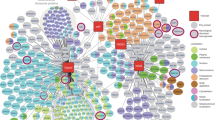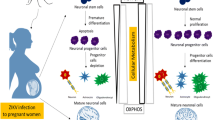Abstract
The recent microcephaly outbreak in Brazil has been associated with Zika virus (ZIKV) infection. The current understanding of damage caused by ZIKV infection is still unclear, since it has been implicated in other neurodegenerative and developmental complications. Here, the differential proteome analysis of human mesenchymal stem cells (hMSC) infected with a Brazilian strain of ZIKV was identified by shotgun proteomics (MudPIT). Our results indicate that ZIKV induces a potential reprogramming of the metabolic machinery in nucleotide metabolism, changes in the energy production via glycolysis and other metabolic pathways, and potentially inhibits autophagy, neurogenesis, and immune response by downregulation of signaling pathways. In addition, proteins previously described in several brain pathologies, such as Alzheimer’s disease, autism spectrum disorder, amyotrophic lateral sclerosis, and Parkinson’s disease, were found with altered expression due to ZIKV infection in hMSC. This potential link between ZIKV and several neuropathologies beyond microcephaly is being described here for the first time and can be used to guide specific follow-up studies concerning these specific diseases and ZIKV infection.



Similar content being viewed by others
References
França GV, Schuler-Faccini L, Oliveira WK, Henriques CM, Carmo EH, Pedi VD et al (2016) Congenital Zika virus syndrome in Brazil: a case series of the first 1501 livebirths with complete investigation. Lancet 388(10047):891–897. https://doi.org/10.1016/S0140-6736(16)30902-3
Schuler-Faccini L, Ribeiro EM, Feitosa IM et al (2016) Possible association between Zika virus infection and microcephaly - Brazil, 2015. MMWR Morb Mortal Wkly Rep 65:59–62. https://doi.org/10.15585/mmwr.mm6503e2
McDonald WH, Yates JR 3rd (2002) Shotgun proteomics and biomarker discovery. Dis Markers 18(2):99–105
Beys-da-Silva WO, Santi L, Berger M, Calzolari D, Passos DO, Guimarães JA, Moresco JJ, Yates JR (2014) Secretome of the biocontrol agent Metarhizium anisopliae induced by the cuticle of the cotton pest Dysdercus peruvianus reveals new insights into infection. J Proteome Res 13:2282–2296. https://doi.org/10.1021/pr401204y
Santi L, Beys-da-Silva WO, Berger M, Calzolari D, Guimarães JA, Moresco JJ, Yates JR (2014) Proteomic profile of Cryptococcus neoformans biofilm reveals changes in metabolic processes. J Proteome Res 13:1545–1559. https://doi.org/10.1021/pr401075f
Berger M, Santi L, Beys-da-Silva WO, Oliveira FMS, Caliari MV, Yates JR, Vieira MAR, Guimarães JA (2015) Mechanisms of acute kidney injury induced by experimental Lonomia obliqua envenomation. Arch Toxicol 89:459–483. https://doi.org/10.1007/s00204-014-1264-0
Garcez PP, Nascimento JM, Vasconcelos JM, Costa RM, Delvecchio R, Trindade P et al (2017) Zika virus disrupts molecular fingerprinting of human neurospheres. Sci Rep 7:40780. https://doi.org/10.1038/srep40780
Zomer HD, Vidane AS, Gonçalves NN, Ambrosio CE (2015) Mesenchymal and induced pluripotent stem cells: general insights and clinical perspectives. Stem Cells Cloning 8:125–134. https://doi.org/10.2147/SCCAA.S88036.
Olmo IG, Carvalho TG, Costa VV, Alves-Silva J, Ferrari CZ, Izidoro-Toledo TC, da Silva JF, Teixeira AL et al (2017) Zika virus promotes neuronal cell death in a non-cell autonomous manner by triggering the release of neurotoxic factors. Front Immunol 8:1016. https://doi.org/10.3389/fimmu.2017.01016
El Costa H, Gouilly J, Mansoy J-M, Chen Q, Levy C, Cartron G et al (2016) ZIKA virus reveals broad tissue and cell tropism during the first trimester of pregnancy. Sci Rep 6:35296. https://doi.org/10.1038/srep35296
Zuk PA, Zhu M, Ashjian P, de Ugarte DA, Huang JI, Mizuno H, Alfonso ZC, Fraser JK et al (2002) Human adipose tissue is a source of multipotent stem cells. Mol Biol Cell 13:4279–4295. https://doi.org/10.1091/mbc.e02-02-0105
Meirelles LDS, Nardi NB (2003) Murine marrow-derived mesenchymal stem cell: isolation, in vitro expansion, and characterization. Br J Haematol 123(4):702–711
Terraciano P, Garcez T, Ayres L, Durli I, Baggio M, Kuhl CP, Laurino C, Passos E et al (2014) Cell therapy for chemically induced ovarian failure in mice. Stem Cells Int 2014:720753. https://doi.org/10.1155/2014/720753
Washburn MP, Wolters D, Yates JR 3rd (2001) Large-scale analysis of the yeast proteome by multidimensional protein identification technology. Nat Biotechnol 19(3):242–247. https://doi.org/10.1038/85686
Xu T, Venable JD, Park SK, Cociorva D, Lu B, Liao L et al (2006) ProLuCID, a fast and sensitive tandem mass spectra-based protein identification program. Mol Cell Proteomics 5:S174
Tabb DL, McDonald WH, Yates JR 3rd (2002) DTASelect and contrast: tools for assembling and comparing protein identifications from shotgun proteomics. J Proteome Res 1:21–26
He L, Diedrich JK, Chu YY, Yates JR (2015) Extracting accurate precursor information for tandem mass spectra by RawConverter. Anal Chem 87(22):11361–11367. https://doi.org/10.1021/acs.analchem.5b02721
Park SK, Venable JD, Xu T, Yates JR 3rd (2008) A quantitative analysis software tool for mass spectrometry-based proteomics. Nat Methods 5(4):319–322. https://doi.org/10.1038/nmeth.1195
Götz S, García-Gómez JM, Terol J, Williams TD, Nagaraj SH, Nueda MJ et al (2008) High-throughput functional annotation and data mining with the Blast2GO suite. Nucleic Acids Res 36(10):3420–3435. https://doi.org/10.1093/nar/gkn176
Gaudet P, Livstone MS, Lewis SE, Thomas PD (2011) Phylogenetic-based propagation of functional annotations within the gene ontology consortium. Brief Bioinform 12(5):449–462. https://doi.org/10.1093/bib/bbr042
Rappaport N, Nativ N, Stelzer G, Twik M, Guan-Golan Y, Stein TI et al (2013) MalaCards: an integrated compendium for diseases and their annotation. Database 2013:018. https://doi.org/10.1093/database/bat018
Rolfe AJ, Bosco DB, Wang J, Nowakowski RS, Fan J, Ren Y (2016) Bioinformatic analysis reveals the expression of unique transcriptomic signatures in Zika virus infected human neural stem cells. Cell Biosci 6:42. https://doi.org/10.1186/s13578-016-0110-x
Szklarczyk D, Morris JH, Cook H, Kuhn M, Wyder S, Simonovic M, Santos A, Doncheva NT et al (2017) The STRING database in 2017: quality-controlled protein–protein association networks, made broadly accessible. Nucleic Acids Res 45:D362–D368. https://doi.org/10.1093/nar/gkw937
Shannon P, Markiel A, Ozier O, Baliga NS, Wang JT, Ramage D, Amin N, Schwikowski B et al (2003) Cytoscape: a software environment for integrated models of biomolecular interaction networks. Genome Res 13(11):2498–2504. https://doi.org/10.1101/gr.1239303
Scardoni G, Tosadori G, Faizan M, Spoto F, Fabbri F, Laudanna C (2014) Biological network analysis with CentiScaPe: centralities and experimental dataset integration. F1000Research 3:139. https://doi.org/10.12688/f1000research.4477.2
Tiwari SK, Dang J, Qin Y, Lichinchi G, Bansal V, Rana TM (2017) Zika virus infection reprograms global transcription of host cells to allow sustained infection. Emerg Microbes Infect 6(4):e24. https://doi.org/10.1038/emi.2017.9
Brahma R, Gurumayum S, Naorem LD, Muthaiyan M, Gopal J, Venkatesan A (2018) Identification of hub genes and pathways in Zika virus infection using rna-seq data: a network-based computational approach. Viral Immunol 31(4):321–332. https://doi.org/10.1089/vim.2017.0116
Caires-Júnior LC, Goulart E, Melo US, Araujo BHS, Alvizi L, Soares-Schanoski A, de Oliveira DF, Kobayashi GS et al (2018) Discordant congenital Zika syndrome twins show differential in vitro viral susceptibility of neural progenitor cells. Nat Commun 9(1):475. https://doi.org/10.1038/s41467-017-02790-9.
Melo CFOR, Delafiori J, Oliveira DN, Guerreiro TM, Esteves CZ et al (2017) Serum metabolic alterations upon Zika infection. Front Microbiol 8:2373. https://doi.org/10.3389/fmicb.2017.01954
Wang L, Yang L, Fikrig E, Wang P (2017) An essential role of PI3K in the control of West Nile virus infection. Sci Rep 7:3724. https://doi.org/10.1038/s41598-017-03912-5
Nakajima S, Kitamura M (2013) Bidirectional regulation of NF-kappaB by reactive oxygen species: a role of unfolded protein response. Free Radic Biol Med 65:162–174. https://doi.org/10.1016/j.freeradbiomed.2013.06.020
Kaur U, Banerjee P, Bir A, Sinha M, Biswas A, Chakrabarti S (2015) Reactive oxygen species, redox signaling and neuroinflammation in Alzheimer’s disease: the NF-kappaB connection. Curr Top Med Chem 15:446–457. https://doi.org/10.2174/1568026615666150114160543
Gorina R, Font-Nieves M, Marquez-Kisinousky L, Santalucia T, Planas AM (2011) Astrocyte TLR4 activation induces a proinflammatory environment through the interplay between MyD88-dependent NFkappaB signaling, MAPK, and Jak1/Stat1 pathways. Glia 59:242–255. https://doi.org/10.1002/glia.21094
Saxton RA, Sabatini DM (2017) mTOR signaling in growth, metabolism, and disease. Cell 168(6):960–976. https://doi.org/10.1016/j.cell.2017.02.004
Sanchez EL, Lagunoff M (2015) Viral activation of cellular metabolism. Virology 479-480:609–618. https://doi.org/10.1016/j.virol.2015.02.038
Qimron U, Tabor S, Richardson CC (2010) New details about bacteriophage T7-host interactions. Microbe 5(3):117–122
Enav H, Mandel-Gutfreund Y, Béjà O (2014) Comparative metagenomic analyses reveal viral-induced shifts of host metabolism towards nucleotide biosynthesis. Microbiome 2:9. https://doi.org/10.1186/2049-2618-2-9
Schrimpf SP, Weiss M, Reiter L, Ahrens CH, Jovanovic M, Malmström J, Brunner E, Mohanty S et al (2009) Comparative functional analysis of the Caenorhabditis elegans and Drosophila melanogaster proteomes. PLoS Biol 7(3):e48. https://doi.org/10.1371/journal.pbio.1000048
Schwanhausser B, Busse D, Li N, Dittmar G, Schuchhardt J, Wolf J et al (2011) Global quantification of mammalian gene expression control. Nature 473(7347):337–342. https://doi.org/10.1038/nature11848.
de Sousa Abreu R, Penalva LO, Marcotte EM, Vogel C (2009) Global signatures of protein and mRNA expression levels. Mol BioSyst 5:1512–1526. https://doi.org/10.1039/b908315d.
Maier T, Guell M, Serrano L (2009) Correlation of mRNA and protein in complex biological samples. FEBS Lett 583:3966–3973. https://doi.org/10.1016/j.febslet.2009.10.036
Rappaport N, Twik M, Plaschkes I, Nudel R, Stein TI, Levitt J et al (2017) MalaCards: an amalgamated human disease compendium with diverse clinical and genetic annotation and structured search. Nucleic Acids Res 45:D877–D887. https://doi.org/10.1093/nar/gkw1012
Sadleir KR, Vassar R (2012) Cdk5 protein inhibition and Aβ42 increase bace1 protein level in primary neurons by a posttranscriptional mechanism implications of cdk5 as a therapeutic target for Alzheimer disease. J Biol Chem 287(10):7224–7235. https://doi.org/10.1074/jbc.M111.333914.
Sontag JM, Nunbhakdi-Craig V, White CL, Halpain S, Sontag E (2012) The protein phosphatase pp2a/bα binds to the microtubule-associated proteins Tau and MAP2 at a motif also recognized by the kinase Fyn: implications for tauopathies. J Biol Chem 287(18):14984–14993. https://doi.org/10.1074/jbc.M111.338681
D’Amelio M, Cavallucci V, Middei S, Marchetti C, Pacioni S, Ferri A et al (2011) Caspase-3 triggers early synaptic dysfunction in a mouse model of Alzheimer’s disease. Nat Neurosci 14:69–76. https://doi.org/10.1038/nn.2709
Liu JS (2011) Molecular genetics of neuronal migration disorders. Curr Neurol Neurosci Rep 11(2):171–178. https://doi.org/10.1007/s11910-010-0176-5
McNamara CR, Degterev A (2011) Small-molecule inhibitors of the PI3K signaling network. Future Med Chem 3(5):549–565. https://doi.org/10.4155/fmc.11.12
Zelenaia O, Schlag BD, Gochenauer GE, Ganel R, Song W, Beesley JS, Grinspan JB, Rothstein JD et al (2000) Epidermal growth factor receptor agonists increase expression of glutamate transporter GLT-1 in astrocytes through pathways dependent on phosphatidylinositol 3-kinase and transcription factor NF-kappaB. Mol Pharmacol 57:667–678. https://doi.org/10.1124/mol.57.4.667
Janssens S, Schotsaert M, Karnik R, Balasubramaniam V, Dejosez M, Meissner A, García-Sastre A, Zwaka TP (2018) Zika virus alters DNA methylation of neural genes in an organoid model of the developing human brain. mSystems 3(1):e00219–e00217. https://doi.org/10.1128/mSystems.00219-17
Schuler-Faccini L, Roehe P, Zimmer ER, Quincozes-Santos A, de Assis AM, Lima EOC, Guimarães JA, Victora C et al (2018) ZIKA virus and neuroscience: the need for a translational collaboration. Mol Neurobiol 55(2):1551–1555. https://doi.org/10.1007/s12035-017-0429-2
Acknowledgements
The authors would like to thank Dr. E. Durigon, ICB/USP, for supplying the ZIKV strain. PMR is a 1A CNPq research fellow. APMV and TFT acknowledges postdoctoral fellowship support by CNPq/HCPA.
Funding
This work was supported by the Brazilian funding agencies Coordenação de Aperfeiçoamento Pessoal de Nível Superior (CAPES), FAPERGS, Edital MCTIC/FNDCT-CNPq/ MEC-CAPES/ MS-Decit / No 14/2016, project 440763/2016-9. The study was also supported by NIH grants NIH/NIHGM P41 GM103533-22 and NIH/NIMH 5 R01 MH067880-14 (to JRY).
Author information
Authors and Affiliations
Corresponding authors
Ethics declarations
Conflict of Interest
The authors declare that they have no conflict of interest.
Ethical Approval
The study was approved by the institutional research ethics committee of Hospital de Clínicas de Porto Alegre (Federal University of Rio Grande do Sul) under protocol # 2018-0059.
Additional information
Walter O. Beys-da-Silva, Rafael L. Rosa, and Lucélia Santi contribute equally for the manuscript.
Electronic Supplementary Material
ESM 1
(PDF 121 kb)
Supplementary Figure 1
PI3K-AKT signaling pathway affected by ZIKV infection in hMSC. Green rectangle: protein down-regulated in ZIKV infection. (PDF 58 kb)
Supplementary Figure 2
mTOR signaling pathway affected by ZIKV infection in hMSC. Green rectangle: proteins down-regulated in ZIKV infection; red rectangle: protein up-regulated in ZIKV infection. (PDF 40 kb)
Supplementary Figure 3
Phosphatidylinositol signaling system affected by ZIKV infection in hMSC. Green rectangle: proteins down-regulated in ZIKV infection. (PDF 177 kb)
Supplementary Table 1
(DOCX 13 kb)
Supplementary Table 2
(XLSX 159 kb)
Supplementary Table 3
(DOCX 26 kb)
Rights and permissions
About this article
Cite this article
Beys-da-Silva, W.O., Rosa, R.L., Santi, L. et al. Zika Virus Infection of Human Mesenchymal Stem Cells Promotes Differential Expression of Proteins Linked to Several Neurological Diseases. Mol Neurobiol 56, 4708–4717 (2019). https://doi.org/10.1007/s12035-018-1417-x
Received:
Accepted:
Published:
Issue Date:
DOI: https://doi.org/10.1007/s12035-018-1417-x




